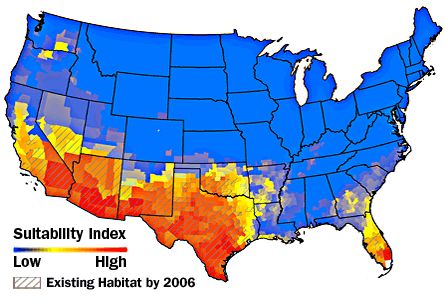Ultra-aggressive Africanized bees, commonly known as “killer bees,” haven’t yet spread to some regions of the United States, but they could. A newly launched, three-year NASA project will combine satellite observations of plant growth and projections of how climate might change in coming years to estimate where Africanized bees could ultimately survive in the wild.

Africanized bees were introduced into the Western Hemisphere by accident: A stray swarm escaped in 1956 from a research station in Brazil where scientists were attempting to breed bees that possessed the tireless work habits of African bees and the docile nature of the European honeybee, now the backbone of most agricultural pollination. Unfortunately, the bees that escaped had a nasty disposition. They are no more poisonous than normal bees, but they are territorial, quick to attack and attack en masse. Also, they quickly spread, says Wayne E. Esaias, a beekeeper who is also a biological oceanographer at NASA’s GoddardSpaceFlightCenter in Greenbelt, Md.
The bees swept through Central America and reached Texas in 1990. Some predictions had the bees reaching North Carolina by 1997, and others had them spreading all the way to the Canadian border, says Esaias. Contrary to expectations, most swarms migrated to the west after they’d breached the border, he notes. Today the bees are established in southern Florida and in a swath that stretches from Texas and southern Oklahoma westward to southern California, Esaias reported May 27 in Fort Lauderdale, Fla., during a meeting of the American Geophysical Union.
So far, killer bees haven’t spread to all regions of the United States considered climatologically suitable for them. One of the biggest mysteries, says Esaias, is why the bees haven’t chosen to take advantage of the more productive and presumably more favorable environmental conditions in the Southeast. The key, he speculates, is that the bees are establishing themselves in areas filled with plants with blooming patterns that mirror those found in their ancestors’ African homeland. For example, in the arid American Southwest, well-populated by the bees, many of the plants bloom profusely only after the rainy season begins.
Esaias and colleagues at the U.S. Department of Agriculture in Beltsville, Md., recently compiled a county-by-county census of the continental United States that includes reports of where Africanized bees now survive in the wild. Using that data, researchers at the U.S. Geological Survey have compiled a map that depicts regions not yet occupied by the bees but considered suitable for them under today’s climate conditions — areas that include northern Florida, southern Georgia, central Arkansas, southern Louisiana and the Central Valley of California. Analyses suggest that Africanized bees could even become established in parts of north central Oregon and southeastern Washington.
Researchers will soon modify the current estimates of which areas of the United States are killer-bee–friendly by incorporating NASA satellite observations of shifts in foliage patterns. The team’s subsequent analyses will include the results of regional climate projections. Those analyses may reveal substantial areas previously unrecognized as suitable for Africanized bees, especially areas where invasive plant species favored by the bees are prevalent, Esaias says.






